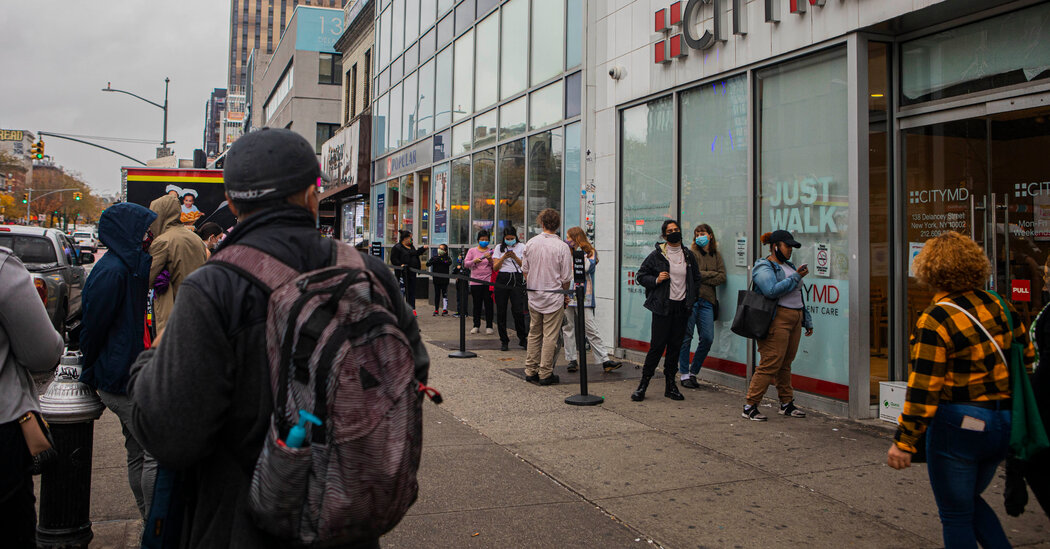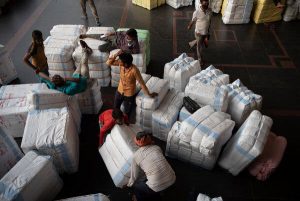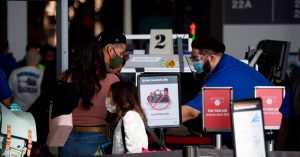Volumes have been written about the ways the culture of parenthood has changed over the past half-century — about the deep connection and mutual dependence forged between nascent adults and the people who raised them, devoted wardens and their ordained. Rarely do we get a physical image that makes the shift so apparent. Covid, strangely, has given this to us.
The confounding visual emerged in advance of Thanksgiving, as lines for testing at urgent-care facilities in New York overtook whole city blocks. They were remarkable both for their size and their particular demographic characteristic — snaking queues of people, nearly all of them in their 20s and 30s, many preparing to visit parents as they tried to control all the perilous variables.
Traveling and convening, of course, go against all the wisdom of science as the virus has dangerously surged across the country. Over and over, public-health agencies and political leaders have reminded us that travel during Thanksgiving is an exercise in destruction. But the heart does not bow to the mandates of a news briefing.
Here was Gov. Andrew M. Cuomo, with his inimitable syntax, on Nov. 19: “I am telling you, Thanksgiving, you look at the infection rate — six, seven, eight days after Thanksgiving, it will be up,’’ he warned. “You’ll then be in early December. Early December — ‘I’ll meet you for a Christmas drink, let’s celebrate Hanukkah, let’s get together, 2020 is ending, it was the worst year in my life, let’s get together and have a drink.’”
All of this, the governor wanted you to know, was a terrible idea. And yet he and his daughters were just as vulnerable to the impulse for communion as anyone else, a humanizing point he has made repeatedly during the pandemic, and one that was reiterated when he canceled Thanksgiving plans with his own family after he was criticized for lecturing his constituents to follow one course as he submitted to the pull of another.
The pull is not easily rejected. Every morning for at least the past week, the line for CityMD on Montague Street in Brooklyn Heights formed hours in advance of the clinic’s opening. By 8:30 or so, it turned a corner on Henry Street and then another onto Pierrepont, marking the center of the neighborhood with an enormous human U.
I approached people, and their stories were essentially always the same — they were hoping to get P.C.R. tests, considered the gold standard for detecting the coronavirus, after which they would quarantine if necessary and then head off to see parents, presuming they weren’t infected. Inevitably, those families lived somewhere along Amtrak’s Northeast corridor, but the children, ever cautious, would drive.
On Monday, as dusk settled in, a young couple finally close enough to the door to feel almost triumphant explained that they had been on line for more than five hours. Between them they had listened to the history podcast “Revolutions,” consumed an audiobook (Ruth Ware’s “One by One”), eaten soup, bought socks (it was cold) and dashed to Macy’s to get sheets for their new apartment.
The errands were made possible during an hour or so of reprieve facilitated by a woman who had put up a sign in the window of her apartment, facing Henry Street, that read: “Covid line waiting person,’’ with a phone number. She was offering to hold the place of people who had grown bored or numb or had an urgent need to buy bedding.
Having recently lost her job, she was hoping to make some money to tide her over until she was working again. She charged $15 an hour, but when I caught up with her on Tuesday morning, she had received only that single request for service.
The Coronavirus Outbreak ›
Words to Know About Testing
Confused by the terms about coronavirus testing? Let us help:
-
- Antibody: A protein produced by the immune system that can recognize and attach precisely to specific kinds of viruses, bacteria, or other invaders.
- Antibody test/serology test: A test that detects antibodies specific to the coronavirus. Antibodies begin to appear in the blood about a week after the coronavirus has infected the body. Because antibodies take so long to develop, an antibody test can’t reliably diagnose an ongoing infection. But it can identify people who have been exposed to the coronavirus in the past.
- Antigen test: This test detects bits of coronavirus proteins called antigens. Antigen tests are fast, taking as little as five minutes, but are less accurate than tests that detect genetic material from the virus.
- Coronavirus: Any virus that belongs to the Orthocoronavirinae family of viruses. The coronavirus that causes Covid-19 is known as SARS-CoV-2.
- Covid-19: The disease caused by the new coronavirus. The name is short for coronavirus disease 2019.
- Isolation and quarantine: Isolation is the separation of people who know they are sick with a contagious disease from those who are not sick. Quarantine refers to restricting the movement of people who have been exposed to a virus.
- Nasopharyngeal swab: A long, flexible stick, tipped with a soft swab, that is inserted deep into the nose to get samples from the space where the nasal cavity meets the throat. Samples for coronavirus tests can also be collected with swabs that do not go as deep into the nose — sometimes called nasal swabs — or oral or throat swabs.
- Polymerase Chain Reaction (PCR): Scientists use PCR to make millions of copies of genetic material in a sample. Tests that use PCR enable researchers to detect the coronavirus even when it is scarce.
- Viral load: The amount of virus in a person’s body. In people infected by the coronavirus, the viral load may peak before they start to show symptoms, if symptoms appear at all.
In the past few years, CityMD has colonized Brooklyn and Manhattan, often displacing beloved businesses that fell prey to rising rents. Now, suddenly, the whole enterprise seemed less like space filler. At another branch on Atlantic Avenue in Boerum Hill, the crowds were nearly as gargantuan. One couple had set themselves up in folding seats. By 10 on Tuesday morning, those toward the front of the line had been incrementally making their way forward since 6:45. In Manhattan, near Gramercy Park, the line for a CityMD on East 23rd Street was so long it nearly converged with a different one unfurling in front of Prohealth Urgent Care, on Third Avenue.
The problem with all this diligence, of taking space on a testing line for the prospect of enjoying pie and families-of-origin in Connecticut, is that anyone with an immediate and pressing need for a test result is left to wait that much longer. One man I met on the Atlantic Avenue line had been there for hours, hoping for the best after his son came home from school after being exposed to the virus.
No one from CityMD seemed to be outside prioritizing who should be let in sooner rather than later. A spokeswoman for the company told me that patients are triaged whenever possible, but that the demand for Covid-related visits and testing had never been higher.
It is hard to imagine a 25-year-old in, say, 1977, bearing all this sacrifice and discomfort for the purpose of sharing a meal with his family in November. As a child, I had an older cousin who consistently approached the holidays in the spirit of absenteeism. No matter what his job was in any given year, he always managed to work on Thanksgiving, something I regarded then as a sign of commitment but would later understand as a means of avoiding predictable disappointment and pain.
In this particular habit he was joined by many co-conspirators, especially and perhaps historically so in the 1970s, when the divide between parents and their grown children seemed vast and unconquerable. A generation of mothers and fathers lost to their vices and distractions had left their young feeding at an empty trough. So there was something distinctly hollow about gathering for an occasion grounded in a holy reverence for nourishment and gratitude.
But things are different now, obviously. The modern parent spends years clearing the path for children, who cling to them unremittingly. A pandemic was no longer a welcome excuse for retreating from obligation because obligation itself had been recast as longing. What once might have been viewed as opportunity — a free pass to skip familial duties — was now a reason for defiance. Against the advice of Dr. Fauci and the entire medical establishment, the kids were on their way home, and there was nothing to be done — over the river and through the obstacle course, assuming they hadn’t moved in already.



















